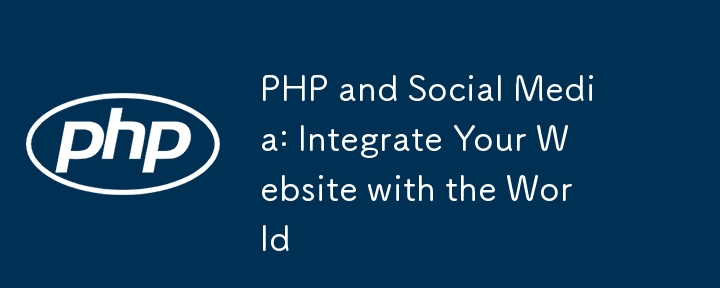PHP and Social Media: Integrate Your Website with the World
PHP provides tools to allow websites to easily integrate social media functions: 1. Dynamically generate social media sharing buttons for users to share content; 2. Integrate with the OAuth library to achieve seamless social media login; 3. Use the HTTP library to capture Get social media data and obtain user profiles, posts and other information.

PHP and Social Media: Make your website global
Introduction
Social media has become an integral part of the modern web, providing businesses and individuals with a valuable platform to interact with their audiences, promote products and build communities. PHP, a popular web development language, provides a range of tools to easily integrate social media functionality into your website.
Use PHP to integrate social media
1. Social media sharing button
You can use PHP to dynamically generate social media sharing Buttons that allow users to share content directly from your site.
$url = 'https://example.com/post'; $title = 'This is an example post'; echo '<a href="https://www.facebook.com/sharer/sharer.php?u=' . urlencode($url) . '" target="_blank">Share on Facebook</a>';
2. Social Media Login
PHP can be integrated with OAuth library for seamless social media login. This allows users to log into your website using their social media accounts, reducing the sign-up process and increasing convenience.
require_once 'vendor/autoload.php';
$provider = new \League\OAuth2\Client\Provider\Facebook([
'clientId' => 'YOUR_CLIENT_ID',
'clientSecret' => 'YOUR_CLIENT_SECRET',
'redirectUri' => 'YOUR_REDIRECT_URI'
]);3. Social media data capture
PHP can use cURL or other HTTP request libraries to capture social media data, such as user profiles, time Line posts and tweets.
$ch = curl_init('https://api.twitter.com/1.1/statuses/user_timeline.json?screen_name=php');
curl_setopt($ch, CURLOPT_RETURNTRANSFER, true);
curl_setopt($ch, CURLOPT_USERPWD, 'YOUR_CONSUMER_KEY:YOUR_CONSUMER_SECRET');
$tweets = json_decode(curl_exec($ch));Practical case
Blog website and Facebook integration
A Facebook integration on a PHP blog website The specific case is as follows:
- Using PHP to generate a Facebook share button, allowing users to share articles to Facebook.
- Integrated OAuth2 and implemented Facebook login function, allowing readers to log in with their Facebook account to comment and write articles.
- Crawled the Facebook API using cURL to get the user profile information and latest articles displayed in the website's home page.
Through these integrations, blogging sites effectively harness the power of social media to increase user engagement, increase sharing, and build an active community.
Conclusion
By leveraging the tools provided by PHP, you can easily integrate social media features into your website. From share buttons to social media logins and data scraping, use these technologies to improve user experience, increase website traffic, and reach a wider audience.
The above is the detailed content of PHP and Social Media: Integrate Your Website with the World. For more information, please follow other related articles on the PHP Chinese website!

Hot AI Tools

Undresser.AI Undress
AI-powered app for creating realistic nude photos

AI Clothes Remover
Online AI tool for removing clothes from photos.

Undress AI Tool
Undress images for free

Clothoff.io
AI clothes remover

AI Hentai Generator
Generate AI Hentai for free.

Hot Article

Hot Tools

Notepad++7.3.1
Easy-to-use and free code editor

SublimeText3 Chinese version
Chinese version, very easy to use

Zend Studio 13.0.1
Powerful PHP integrated development environment

Dreamweaver CS6
Visual web development tools

SublimeText3 Mac version
God-level code editing software (SublimeText3)

Hot Topics
 1359
1359
 52
52
 CakePHP Project Configuration
Sep 10, 2024 pm 05:25 PM
CakePHP Project Configuration
Sep 10, 2024 pm 05:25 PM
In this chapter, we will understand the Environment Variables, General Configuration, Database Configuration and Email Configuration in CakePHP.
 PHP 8.4 Installation and Upgrade guide for Ubuntu and Debian
Dec 24, 2024 pm 04:42 PM
PHP 8.4 Installation and Upgrade guide for Ubuntu and Debian
Dec 24, 2024 pm 04:42 PM
PHP 8.4 brings several new features, security improvements, and performance improvements with healthy amounts of feature deprecations and removals. This guide explains how to install PHP 8.4 or upgrade to PHP 8.4 on Ubuntu, Debian, or their derivati
 CakePHP Date and Time
Sep 10, 2024 pm 05:27 PM
CakePHP Date and Time
Sep 10, 2024 pm 05:27 PM
To work with date and time in cakephp4, we are going to make use of the available FrozenTime class.
 CakePHP Working with Database
Sep 10, 2024 pm 05:25 PM
CakePHP Working with Database
Sep 10, 2024 pm 05:25 PM
Working with database in CakePHP is very easy. We will understand the CRUD (Create, Read, Update, Delete) operations in this chapter.
 CakePHP File upload
Sep 10, 2024 pm 05:27 PM
CakePHP File upload
Sep 10, 2024 pm 05:27 PM
To work on file upload we are going to use the form helper. Here, is an example for file upload.
 CakePHP Routing
Sep 10, 2024 pm 05:25 PM
CakePHP Routing
Sep 10, 2024 pm 05:25 PM
In this chapter, we are going to learn the following topics related to routing ?
 Discuss CakePHP
Sep 10, 2024 pm 05:28 PM
Discuss CakePHP
Sep 10, 2024 pm 05:28 PM
CakePHP is an open-source framework for PHP. It is intended to make developing, deploying and maintaining applications much easier. CakePHP is based on a MVC-like architecture that is both powerful and easy to grasp. Models, Views, and Controllers gu
 CakePHP Creating Validators
Sep 10, 2024 pm 05:26 PM
CakePHP Creating Validators
Sep 10, 2024 pm 05:26 PM
Validator can be created by adding the following two lines in the controller.




